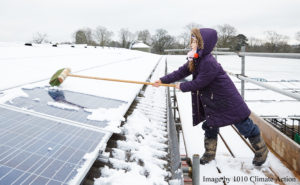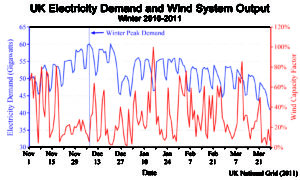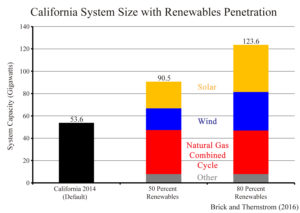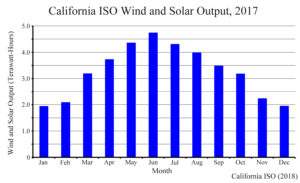100 Percent Renewables—Poor Policy for Ratepayers
By Steve Goreham -- October 29, 2018“Cities and states pursuing 100 percent renewable electricity lay the foundation for a future painful lesson. Households and businesses will experience the shock of rapidly rising electricity prices as more renewables are added to the system.”
Two states and more than 80 cities and counties have now announced a goal of receiving 100 percent of their electricity from renewable sources. Wind, solar, and biofuels are proposed to replace electricity from coal, natural gas, and nuclear power plants. But evidence is mounting that 100 percent renewables is poor policy for US households and businesses.
More than 80 cities announced commitments to get 100 percent of their energy from renewable sources. Minneapolis committed to attaining 100 percent renewable electricity by 2030, Salt Lake City by 2032, and St. Louis by 2035. Nine counties and two states, California and Hawaii, have also made 100 percent renewable pledges.
Some cites already claim to get all power from renewables, generally by using a little electricity “sleight of hand.” Rock Port, Missouri claims to be the first US community powered by wind because it has a local wind farm. But when the wind doesn’t blow, Rock Port gets power from other generators in Missouri, a state that gets 77 percent of its electricity from coal and 97 percent from non-renewables in total.
On September 10, Governor Jerry Brown signed Senate Bill 100, committing California to 100 percent renewable electricity by 2045. Brown stated,
It’s not going to be easy. It will not be immediate. But it must be done…California is committed to doing whatever is necessary to meet the existential threat of climate change.
But cities and states pursuing 100 percent renewable electricity lay the foundation for a future painful lesson. Households and businesses will experience the shock of rapidly rising electricity prices as more renewables are added to the system.
Intermittency Problem
Wind and solar cannot replace output from traditional coal, natural gas, and nuclear power plants, despite claims to the contrary. Wind and solar are intermittent generators. Wind output varies dramatically from high output to zero, depending upon weather conditions. Solar output is available for only about six hours each day when the sun is overhead and disappears completely on cloudy days or after a snowfall. Hydropower is a renewable source that can replace traditional power plants, but even this source is insufficient in years of drought or low snow runoff.
Experience shows that utilities can only count on about 10 percent of the nameplate capacity of a wind or solar facility as an addition to power system capacity. For example, on December 7, 2011, the day of peak winter electricity demand in the United Kingdom, the output of more than 3,000 wind turbines in the UK was less than five percent of rated output. The UK House of Lords recognized the problem a decade ago, stating “The intermittent nature of wind turbines…means they can replace only a little of the capacity of fossil fuel and nuclear power plants if security of supply is to be maintained.”
To achieve “deep decarbonization,” states will need to keep 90 percent of traditional power plants and add increasing amounts of wind and solar to existing systems. Total system capacity must first double and then triple as 100 percent renewable output is approached. A 2016 study by Brick and Thernstrom projected that California’s system capacity would need to increase from 53.6 gigawatts to 90.5 gigawatts at 50 percent renewables and to 123.6 gigawatts at 80 percent renewable output.
Rising system capacity means enormous electricity cost. In 2017, California received 20 percent of its electricity from renewable sources, excluding power from large hydroelectric plants. California 2017 residential electricity rates were 18.24 cents per kilowatt-hour, 50 percent higher than any other US western state.
From 2008 to 2017, California power rates rose 25 percent compared to the US national average increase of about 7 percent. But the worst is yet to come. As California adds renewable capacity to approach 100 percent renewables, generated cost of electricity will likely triple.
International examples show soaring electricity prices from renewables penetration. High levels of wind and solar in Germany and Denmark produced household electricity prices four times US rates. Renewable programs pushed power prices in five Australian provincial capital cities up 60 to 160 percent over the last decade. Wind, solar, and biofuel penetration in Ontario, Canada drove electricity prices up more than 80 percent from 2004 to 2016. Renewable output in these locations remains far below 100 percent.
Batteries … No Panacea
Green energy advocates recognize renewable intermittency and hope that advances in battery technology will save the day. Large-scale commercial batteries, they claim, will be able to store power during high levels of renewable output and then deliver power to the grid when wind and solar output is low.
But batteries are not the answer because of the large seasonal variation in renewable output. For example, wind and solar output in California in December and January is less than half of the output in summer months. Commercial large-scale batteries available today are rated to deliver stored electricity for only two hours or ten hours duration. No batteries exist that can store energy in the summer and then deliver it during the winter when renewable output is very low.
Conclusion
Superstition is powerful. There is no evidence that 100 percent renewable efforts, all combined, will have a measurable effect on global temperatures. Instead, cities and states that pursue 100 percent renewable policies will learn the hard lesson of skyrocketing electricity prices.
———–
Steve Goreham is a popular speaker on the environment, business, and public policy and author of the Outside the Green Box: Rethinking Sustainable Development.




[…] [Originally Published at Master Resource] […]
[…] [Originally Published at Master Resource] […]
Nah.
They’ll just promise to make the “rich” pay for your electricity.
[…] Full post […]
Sometimes people will just have to experience the lunacy of these policies first hand, before they wake up.
[…] published in Master Resource. Republished here at the request of the author. Steve Goreham is a speaker on the environment, […]
[…] printed in Grasp Useful resource. Republished right here on the request of the creator. Steve Goreham is a speaker on the setting, […]
https://futurism.com/world-without-blackouts-power-future-renewable-energy/
It’s been proven that what this article states as not doable is precisely doable.
BTW, renewables are taking electricity prices down, not up. Even to negative prices. This is an issue but not the one stated in this article.
Sorry, Patrick! The nation would delight in “…negative prices” but after massive construction costs, and zero wind days, your “It’s been proven…” claim demands proof, or are you in a position to personally guarantee its truth?
[…] By Steve Goreham / Originally published in Master Resource. […]
[…] 100% Renewable, is Bad Policy for Ratepayers […]
[…] 100% Renewable, is Bad Policy for Ratepayers […]
[…] will be in addition to existing power generation plants, 90 percent of which must be maintained to provide security of electricity supply when the wind doesn’t blow and the sun doesn’t […]